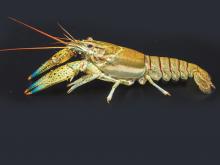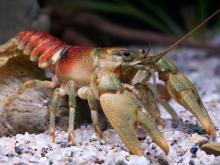Aquatic Invertebrates
Media

Species Types
Scientific Name
Lacunicambarus ludovicianus (syn. Cambarus ludovicianus)
Description
The painted devil crayfish is a burrowing lowland species. In Missouri, it is known from only a few locations in the Bootheel. Its overall color is olive green to blue, with reddish and cream markings.
Media

Species Types
Scientific Name
Faxonius nais (formerly Orconectes nais)
Description
The water nymph crayfish is normally found in streams but can also be found in a variety of other aquatic habitats. It is greenish brown or brown with no prominent markings. Its known distribution in Missouri is spotty.
Media

Species Types
Scientific Name
Faxonius eupunctus (formerly Orconectes eupunctus)
Description
The coldwater crayfish has a very localized distribution in the Eleven Point River system. It is stout, with a blue-green head and pincers and dark, rust-brown carapace. It is an imperiled species.
Media

Species Types
Scientific Name
Venustaconcha ellipsiformis and V. pleasii
Description
These small mussels use darters, a type of fish, as hosts for their young.
Media

Species Types
Scientific Name
Toxolasma parvus
Description
These diminutive mollusks are the smallest of Missouri’s freshwater mussels.
Media

Species Types
Scientific Name
Bivalve molluscs in order Unionoida
Description
Secretive and seldom seen, freshwater mussels are extraordinarily diverse in Missouri. We have nearly 70 species within our borders. Many are declining, and several are endangered.
See Also
About Aquatic Invertebrates in Missouri
Missouri's streams, lakes, and other aquatic habitats hold thousands of kinds of invertebrates — worms, freshwater mussels, snails, crayfish, insects, and other animals without backbones. These creatures are vital links in the aquatic food chain, and their presence and numbers tell us a lot about water quality.





















